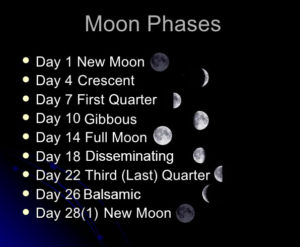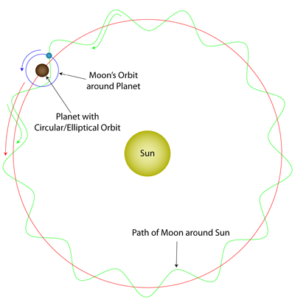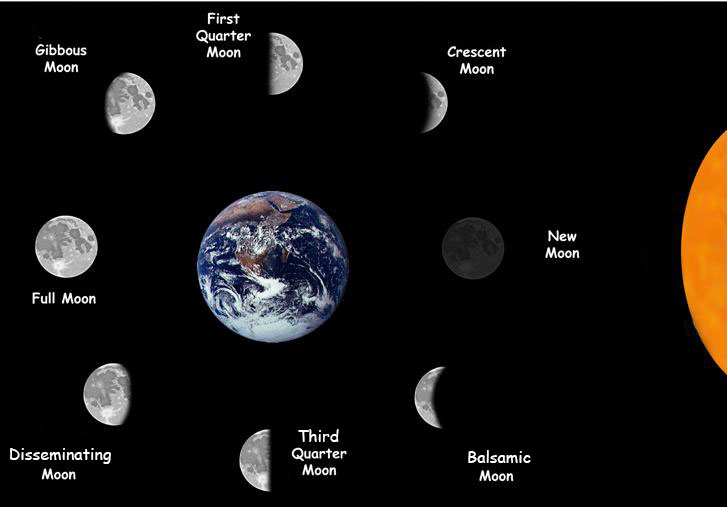I think in honor of the Full Moon phase today, I am beginning an extended lesson on The Moon. Part of AstroGardens is examining and living the affect of astronomy and astrology on my garden. Anyone who has followed astrology or Oracle Report over the past 8 years will know that we follow the moon phases regularly and talk about it at length.
So, I will be putting together short posts to explain it. That way when I throw out some blanket statement like – “It’s Full Moon and you know what that means,” you will not first think that there will be werewolves all over the place. But you might take pause if you find yourself in the Emergency Room with a couple hundred other people.
Some notes on Astronomy
In my freshman year in college, I decided to take an Astronomy class. As a business major, I was required to take a science course with a lab. I had already studied both Chemistry and Biology in high school and was looking for something different.
And Astronomy sounded so cool. I could go on star gazing tours, go visit the observatory (Palomar Mountain was only about 30 miles away and the College had a partnership there). Learning about the planets and the solar system had more of an appeal to me than chemicals and dissections.
Besides this, it was one of the few classes that I could get. San Diego State University boasted over 45,000 students at the time. Most classes were held in large lecture halls, and still would fill to capacity. You took what you could get.
Day one in the class re educated me quickly about the “fun” in astronomy. Astronomy could be better described as applied mathematics, chemistry, and physics all together.
I have never taken physics, so most of my simplistic descriptions of physics principles will be borrowed from someone else’s work who knows WTF they are talking about.
As my major would eventually change from Business to Economics (which is another applied mathematics, specifically statistics and calculus, field) the mode of learning fit right into my own abilities.

Astronomy is all about DESCRIBING what is going on in the universe around us. It provides the descriptive information that has helped us to ask some of the more important questions about life, the universe and everything.
The location of the moon in relation to the earth and the sun is a significant source of the energy that we experience here on Earth. In fact, since it is the closest object in our solar system to the Earth, while not being the largest, it exerts the greatest gravitational influence upon us.
 The Moon, as our satellite, travels around our planet every 28 or so days or about 13 times within each calendar year. See the diagram to the left that notes the basic synodic (monthly) path of the earth around the sun.
The Moon, as our satellite, travels around our planet every 28 or so days or about 13 times within each calendar year. See the diagram to the left that notes the basic synodic (monthly) path of the earth around the sun.
A few quick calculations will tell you that this means that it does not accurately match up with the standard Gregorian Calendar of 365.2422 days – requiring a leap-day every 4 years (and a curse to any kid born on that day – February 29).

For my purposes, I will be describing the phases by the following names:
New Moon –
Crescent Moon Phase –
First Quarter Phase –
Gibbous Moon –
Full Moon –
Disseminating Moon Phase–
Third Quarter Phase–
Balsamic Moon Phase –
I bring this up primarily because you will find the lunar phases called many different things. One of the most confusing that I have found are the difference between Waxing and Waning.
Between New Moon and Full Moon, the moon is Waxing, or getting bigger
Between Full Moon and New Moon, the moon is Waning, or getting smaller
But What about the Tides?
 Remember that in addition to the moon moving around the Earth, remember that each day, the earth revolves once around on its axis. This means that during the course of the day, the planet will react (bulge) as it passes the moon. This compression in and out as the planet spins causes the tidal forces in all water on the planet. This is easy to see in the case of the oceans or in a large lake, where the movement of the water can be measured. But when you look at smaller bodies of water (like the 75 odd percent of each person’s body that is made up of water).
Remember that in addition to the moon moving around the Earth, remember that each day, the earth revolves once around on its axis. This means that during the course of the day, the planet will react (bulge) as it passes the moon. This compression in and out as the planet spins causes the tidal forces in all water on the planet. This is easy to see in the case of the oceans or in a large lake, where the movement of the water can be measured. But when you look at smaller bodies of water (like the 75 odd percent of each person’s body that is made up of water).
As a beginning point, this discusses some of the basics about our lunar satellite is a good start. In the end, all of these forces have impacts on our life. In this case, we want to know about what it does to our gardens.

1 Comment
Comments are closed.